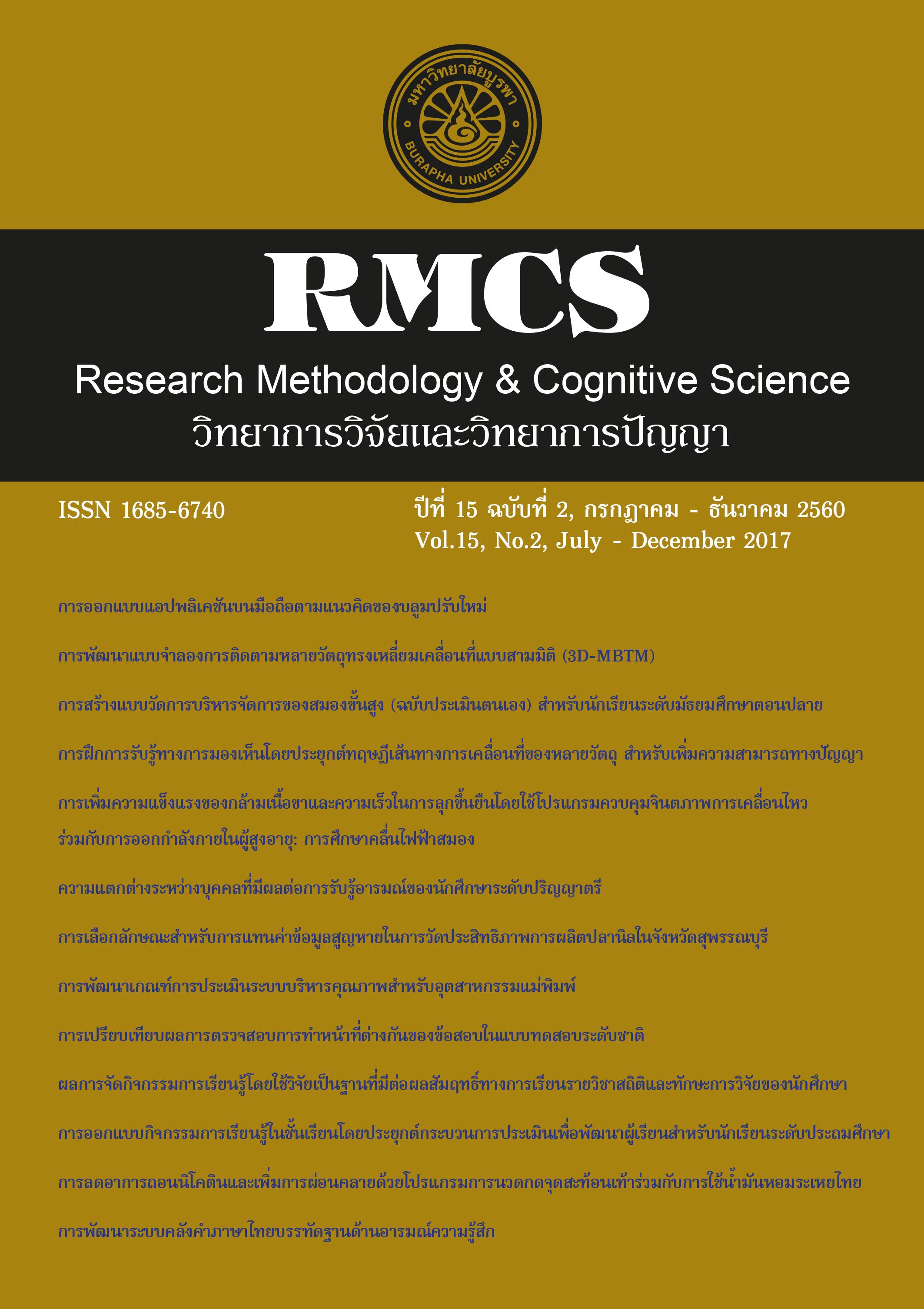Development of Assessment Criteria for a Quality Management System in the Mold and Die Industry
Main Article Content
Abstract
The purposes of this research were (1) to develop the assessment criterion of the quality
management system for mold and die industry using a modified Three Round e-Delphi procedure
involving 21experts, and to rank the developed components and indicators with Analytic Hierarchy
Process (AHP); (2) to develop an online program; and (3) to compare the results of quality
management system level between medium & small, and large firms in mold and die industry.
Data were analyzed using Mann-Whitney U test. The results were as follows:
1. The assessment criterion for the quality management system in the mold and die industry
comprised of eight components (33indicators): (1) Innovation; (2) Leadership; (3) Operation; (4)
Context of Organization; (5) Planning; (6) Support; (7) Performance Evaluation; (8) Improvement.
Assessing for quality management system was categorized into five levels from 1(strongly needing
improvement) to 5(excellent).
2. The developed online program for assessing quality of the management system for the
mold and die industry was suitable for used on Black-Box Testing method.
3. The comparison of quality management system for the mold and die industry between
medium & small, and large firms showed that assessment result of quality management system
for the mold and die industry in large firm was a higher level than medium & small firm (p<.05).
The results confirmed that the assessment criteria are suitable for assessing the quality
management system for the mold and die industry.
Article Details
References
อุตสาหกรรม.
การค้าไทย. (2558). มูลค่าสินค้าส่งออกสำคัญ. วันที่ค้นข้อมูล 10กันยายน 2558, เข้าถึงได้จาก http://www2.ops3.
moc.go.th/
พิมพ์ชนก เต็งเจริญ, คณิต เฉลยจรรยา และวิเชียร เกตุสิงห์. (2558). การพัฒนารูปแบบสมรรถนะ ตัวแทนฝ่ายบริหารด้าน
คุณภาพในสาขาอุตสาหกรรมเครื่องจักรกลและอุปกรณ์ของประเทศไทย. วารสารพัฒนาเทคนิคศึกษา, 93(1), 53-62.
สภาอุตสาหกรรมแห่งประเทศไทย. (2557). นโยบายประธานสภาอุตสาหกรรมแห่งประเทศไทยวาระ ปี 2559–2557.
วันที่ค้นข้อมูล 10กันยายน 2558, เข้าถึงได้จาก http://www.fti.or.thCenters for Medicare and Medicaid Services (CMS).
(2008). Selecting a development approach. Office of Information Services, 3(4), 1-10.
Chou, C. (2002). Developing the e-Delphi system: a webbased forecasting tool for educational research.
British Journal of Educational Technology, 33(2), 233-236.
Creswell, J. W. (2014). Educational Research: Planning, Conducting, and Evaluating Quantitative and
Qualitative Research(4th ed.). Harlow, Essex: Pearson.
Das, A., Paul, H., & Swierczek, F. W. (2008). Developing and validating total quality management (TQM)
constructs in the context of Thailand 's manufacturing industry. Benchmarking: An International Journal,
15(1), 52-72.
Edmonds, W. A., & Kennedy, T. D. (2013). An applied reference guide to research designs: Quantitative,
qualitative, and mixed methods. London:SAGE.
Fatemi, S. M., Wei, C. C., & Moayeryfard, H. (2016). CSFs for Total Quality Management (TQM) in Service
Organizations: Review. International Journal of Academic Research in Business and Social Sciences,
6(1), 254-264.
Franklin, E. A. (2011). Greenhouse facility management experts identification of competencies and teaching
methods to support secondary agricultural education instructors: A modified delphi study. Journal of
Agricultural Education, 52(4), 150-161.
Krittanathip, V., Rakkran, S., Cha-um, S., & Klamdej, I. (2013). Development of weighting on self-assessment
evaluation for total quality management: A case study of wholesale sectors. Procedia - Social and
Behavioral Sciences, 88,49-60.
Levine, D. I., & Toffel, M. W. (2010). Quality management and job quality: How the ISO 9001 standard for
quality management systems affects employees and employers. Management Science, 56(6),
978-996.
Liu, T. W., & Chin, K. S. (2010). Development of audit system for intellectual property management
excellence. Expert Systems with Applications, 37(6), 4504-4518.
Macmillan, T. T. (1971). The Delphi technique.Paper Presented at the annual meeting of the California
Junior Colleges Associations Committee on Research and Development,May 3-5, 1971, Monterey: California.
Nachar, N. (2008). The Mann-Whitney U: a test for assessing whether two independent samples
come from the same distribution. Tutorials in Quantitative Methods for Psychology, 4(1), 13-20.
Naksawat, S., Chadcham, S., & Makmee, P. (2015). Development of the Human Capital Assessment
Criteria for Industrial Sector. Research Methodology & Cognitive Science, 13(2), 90-108.
Navickas, V., & Malakauskaite, A. (2009). The impact of clusterization on the development of small
and medium and sized enterprise (SME) sector. Journal of Business Economics and Management,
10(3), 255-259.
Organisation internationale des Constructeures d’ Automobiles: OICA. (2015). Production statistic.
Retrieved March 25, 2015, from http://www.oica.net/category/production-statistics/2012-statistics/
Saaty, T. L., & Vargas, L. G. (2012). Models, methods, concepts & applications of the analytic hierarchy
process (Vol. 175). Springer Science & Business Media.
Von der Gracht, H. A. (2012). Consensus measurement in Delphi studies. Technological Forecasting &
Social Change, 79(8), 1525-1536.
Wagner, C., et al. (2014). Development and validation of an index to assess hospital quality management
systems. International Journal for Quality in Health Care, 26(1), 16-26.
Wiersma, W., & Jurs, S. (2009). Research methods in education: An introduction. Massachusetts: Pearson.
